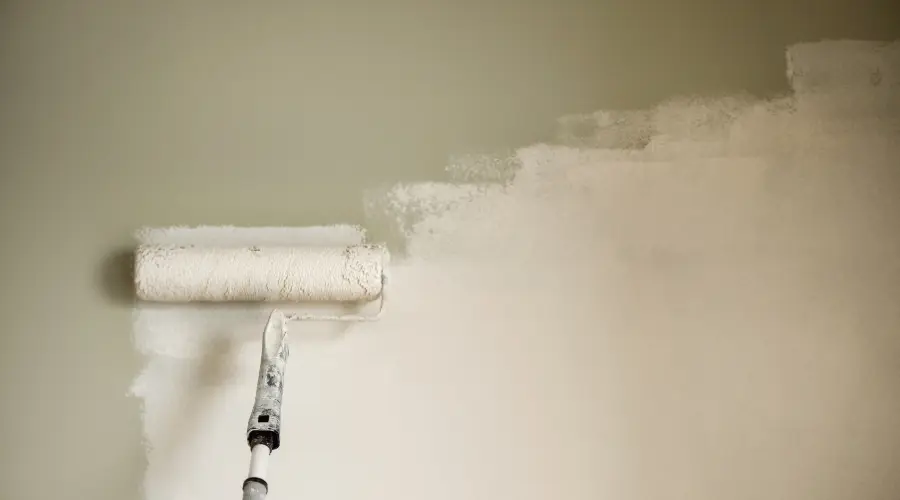Key Takeaway
- Low-VOC paints offer a safer, healthier, and environmentally friendly alternative to traditional paints.
- They reduce indoor air pollution, protect your family’s health, and align with sustainable living—all without compromising performance or affordability.
Understanding VOCs and Their Role in Paint
VOCs (Volatile Organic Compounds) are chemical compounds commonly found in traditional paints. They assist with paint’s drying time, adhesion, and application properties, but they come at a cost. As paint dries, VOCs are released into the air, causing a process known as off-gassing. This release can linger for days or even weeks, affecting indoor air quality.
The effects of VOC exposure range from short-term headaches and dizziness to long-term respiratory issues and other health risks. In addition, VOCs contribute to environmental problems like ozone depletion and smog formation.
Why Is Low-VOC Paint Important?
Low-VOC paints address the health and environmental concerns associated with traditional paints. These paints contain minimal levels of volatile organic compounds, dramatically reducing harmful emissions during and after application.
By opting for low-VOC paints, homeowners protect their families from indoor air pollution, support a healthier planet, and enjoy a virtually odorless painting experience. Modern advancements ensure these paints deliver vibrant colors, durability, and performance comparable to their high-VOC counterparts.
7 Reasons to Use Low-VOC Paints
- Improved Indoor Air Quality
Low-VOC paints emit fewer harmful fumes, leading to cleaner, healthier air inside your home. This is especially critical for children, elderly individuals, and anyone with respiratory sensitivities.
- Healthier Living Environment
Traditional paints can cause headaches, nausea, and irritation. Low-VOC options minimize these risks, fostering a safer space for your family.
- Eco-Friendly Choice
By reducing chemical emissions, low-VOC paints contribute to sustainable living and help reduce air pollution. They align perfectly with green building initiatives.
- Odorless Application
Low-VOC paints produce little to no odor, making the painting process more pleasant. This is ideal for people who need to occupy freshly painted spaces quickly.
- Compliance with Regulations
Many regions now enforce strict VOC limits. Low-VOC paints ensure compliance while offering superior performance and style.
- Wide Availability and Versatility
Low-VOC paints are available in various finishes, colors, and formulas, catering to any aesthetic or functional need.
- Comparable Cost to Traditional Paints
Contrary to popular belief, low-VOC paints are not significantly more expensive than standard paints, making them accessible for all budgets.
Is Low-VOC Paint More Expensive?
The idea that low-VOC paints cost significantly more than traditional options is essentially a myth. While prices can vary based on brand and quality, low-VOC paints are generally priced within the same range as regular paints. Some premium eco-friendly brands may be slightly higher, but the health and environmental benefits outweigh the marginal cost difference.
In addition, many major paint manufacturers now offer low-VOC formulations as part of their standard lineup, making them more affordable than ever.
FAQs About Low-VOC Paints
Q: What does “low-VOC” mean?
A: Low-VOC paints contain fewer volatile organic compounds, reducing harmful emissions and odors compared to traditional paints.
Q: Can I use low-VOC paint for all surfaces?
A: Yes! Low-VOC paints are versatile and suitable for walls, ceilings, furniture, and more.
Q: How can I ensure a paint is low-VOC?
A: Look for certification labels like Green Seal, GREENGUARD, or LEED compliance on the packaging.
Q: Do low-VOC paints take longer to dry?
A: Drying times are similar to traditional paints, with some low-VOC options and even faster drying due to modern formulations.
Q: Are low-VOC paints safe for pregnant women and children?
A: Yes, they are a much safer alternative due to minimal harmful emissions. However, always ensure proper ventilation during application.
Conclusion: Make the Healthier, Smarter Choice
Low-VOC paints are not just a trend—they’re a necessity for modern homes. By choosing these paints, you protect your family’s health, contribute to environmental sustainability, and create a beautiful, odor-free living space.
In today’s world, where health and environmental consciousness are paramount, low-VOC paints stand as a symbol of innovative and responsible living. Elevate your home with this simple yet powerful choice and enjoy the benefits for years to come.
Upgrade your home with Low-VOC paints today and make a difference that truly matters.
Your Dream Home Starts with a Perfect Coat of Paint!
Choose NewCity house Painter for reliable, high-quality painting services. Contact us today for your free estimate and make your home a masterpiece!
Key Takeaway
- Low-VOC paints offer a safer, healthier, and environmentally friendly alternative to traditional paints.
- They reduce indoor air pollution, protect your family’s health, and align with sustainable living—all without compromising performance or affordability.
Understanding VOCs and Their Role in Paint
VOCs (Volatile Organic Compounds) are chemical compounds commonly found in traditional paints. They assist with paint’s drying time, adhesion, and application properties, but they come at a cost. As paint dries, VOCs are released into the air, causing a process known as off-gassing. This release can linger for days or even weeks, affecting indoor air quality.
The effects of VOC exposure range from short-term headaches and dizziness to long-term respiratory issues and other health risks. In addition, VOCs contribute to environmental problems like ozone depletion and smog formation.
Why Is Low-VOC Paint Important?
Low-VOC paints address the health and environmental concerns associated with traditional paints. These paints contain minimal levels of volatile organic compounds, dramatically reducing harmful emissions during and after application.
By opting for low-VOC paints, homeowners protect their families from indoor air pollution, support a healthier planet, and enjoy a virtually odorless painting experience. Modern advancements ensure these paints deliver vibrant colors, durability, and performance comparable to their high-VOC counterparts.
7 Reasons to Use Low-VOC Paints
- Improved Indoor Air Quality
Low-VOC paints emit fewer harmful fumes, leading to cleaner, healthier air inside your home. This is especially critical for children, elderly individuals, and anyone with respiratory sensitivities.
- Healthier Living Environment
Traditional paints can cause headaches, nausea, and irritation. Low-VOC options minimize these risks, fostering a safer space for your family.
- Eco-Friendly Choice
By reducing chemical emissions, low-VOC paints contribute to sustainable living and help reduce air pollution. They align perfectly with green building initiatives.
- Odorless Application
Low-VOC paints produce little to no odor, making the painting process more pleasant. This is ideal for people who need to occupy freshly painted spaces quickly.
- Compliance with Regulations
Many regions now enforce strict VOC limits. Low-VOC paints ensure compliance while offering superior performance and style.
- Wide Availability and Versatility
Low-VOC paints are available in various finishes, colors, and formulas, catering to any aesthetic or functional need.
- Comparable Cost to Traditional Paints
Contrary to popular belief, low-VOC paints are not significantly more expensive than standard paints, making them accessible for all budgets.
Is Low-VOC Paint More Expensive?
The idea that low-VOC paints cost significantly more than traditional options is essentially a myth. While prices can vary based on brand and quality, low-VOC paints are generally priced within the same range as regular paints. Some premium eco-friendly brands may be slightly higher, but the health and environmental benefits outweigh the marginal cost difference.
In addition, many major paint manufacturers now offer low-VOC formulations as part of their standard lineup, making them more affordable than ever.
FAQs About Low-VOC paints
Q: What does “low-VOC” mean?
A: Low-VOC paints contain fewer volatile organic compounds, reducing harmful emissions and odors compared to traditional paints.
Q: Can I use low-VOC paint for all surfaces?
A: Yes! Low-VOC paints are versatile and suitable for walls, ceilings, furniture, and more.
Q: How can I ensure a paint is low-VOC?
A: Look for certification labels like Green Seal, GREENGUARD, or LEED compliance on the packaging.
Q: Do low-VOC paints take longer to dry?
A: Drying times are similar to traditional paints, with some low-VOC options and even faster drying due to modern formulations.
Q: Are low-VOC paints safe for pregnant women and children?
A: Yes, they are a much safer alternative due to minimal harmful emissions. However, always ensure proper ventilation during application.
Conclusion:
Low-VOC paints are not just a trend—they’re a necessity for modern homes. By choosing these paints, you protect your family’s health, contribute to environmental sustainability, and create a beautiful, odor-free living space.
In today’s world, where health and environmental consciousness are paramount, low-VOC paints stand as a symbol of innovative and responsible living. Elevate your home with this simple yet powerful choice and enjoy the benefits for years to come.
Upgrade your home with Low-VOC paints today and make a difference that truly matters.
Your Dream Home Starts with a Perfect Coat of Paint!
Choose NewCity house Painter for reliable, high-quality painting services. Contact us today for your free estimate and make your home a masterpiece!







